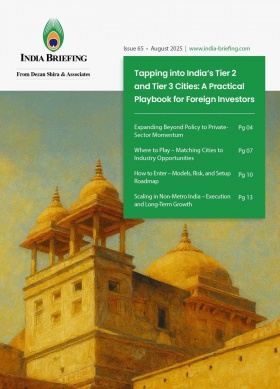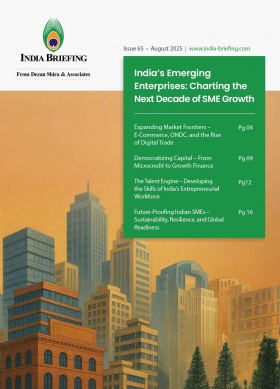How Amazon Inc. Built its India Fulfilment Empire
Amazon’s India fulfillment network runs through air, rail, and road freight across 100 centers and 14,000 pin codes. The logistics giant has digitized 12 million micro, small and medium enterprises (MSMEs), enabled US$13 billion in exports, and deployed 10,000 electric vehicles (EVs) through its logistics platform.
Evolution of Amazon’s fulfillment empire
Early phase (2013-2016)
Amazon entered the Indian market in June 2013, at a time when foreign direct investment (FDI) regulations limited foreign participation in e-commerce. Indian consumers were only beginning to explore online retail as internet access became more widespread. Rather than prioritizing speed, Amazon focused on building reliability through efficient delivery and hassle-free returns. This strategy helped establish consumer trust and laid the foundation for broader acceptance of e-commerce in India.
Consolidation phase (2017-2020)
After establishing a foothold, Amazon shifted its strategy toward scaling operations. Between 2017 and 2020, the company built large fulfillment centers in major Tier-1 cities, such as Hyderabad, Delhi, and Bengaluru, along with specialized facilities for large appliances and grocery items. It also integrated Amazon Easy and Amazon Now with its logistics ecosystem, enabling seamless coordination between local deliveries and its global supply chain.
Acceleration phase (2020-2023)
The COVID-19 pandemic marked a pivotal moment for India’s e-commerce landscape. During this period, Amazon accelerated its expansion beyond metros, strengthening its presence across Tier-2 and Tier-3 cities through the addition of regional sortation centers. In January 2023, the company introduced Amazon Air, becoming the first e-commerce player in India to establish a dedicated air cargo network.
Maturity phase (2024-2025)
By 2025, Amazon’s logistics network in India has grown to encompass over 100 fulfillment centers. During this phase, the company transitioned from a captive logistics model, where operations were managed in-house, to a platform-based logistics model, enabling third-party participation through its centralized infrastructure. Amazon has also monetized this network by introducing services such as Amazon Shipping and Multi-Channel Fulfillment (MCF), extending its capabilities beyond its own marketplace.
Current networks and infrastructure scale
As of 2025, Amazon operates an extensive fulfillment network in India. The company’s recent expansion demonstrates its aggressive business expansion plans:
- It launched 12 new fulfillment centers in 2025 across Delhi NCR, Bengaluru, Kolkata, Nagpur, Thane, Visakhapatnam, Hubballi, Hooghly, Hyderabad, Tiruvallur, and Krishnagiri.
- Amazon’s total storage capacity now exceeds 43 million cubic feet across 15 states, prior to the addition of the new centers.
- The company has established 6 new sortation centers in Hubballi, Trivandrum, Rajpura, Gorakhpur, Moradabad, and Prayagraj.
- It has 1,950 delivery stations managed directly or through local partners.
- Over 100 micro-fulfillment centers (MFCs) already operational, with plans to expand this number to 300 by the end of 2025.
In 2025, Amazon announced an investment of INR 20 billion (US$227 million) to expand and modernize its fulfillment ecosystem. This investment builds on Amazon’s broader US$26 billion commitment in India by 2030, marking one of the largest foreign investment plans in the country’s logistics and retail sectors.
Innovations for last mile delivery
Amazon operates through multiple delivery channels to reach the last-mile customer. The company operates its own extensive delivery network, covering 100 percent of India’s serviceable PIN codes. It also partners with more than 28,000 third-party delivery partners across India. It has built a Delivery Service Partner (DSP) program, which lets small entrepreneurs to operate local delivery networks under Amazon’s brand.
To strengthen its position in India’s quick commerce segment, Amazon is expanding the Amazon Now program, which currently offers 10-minute deliveries in Delhi, Bengaluru, and Mumbai. These operations rely on strategically located micro-fulfillment centers (MFCs), each serving neighborhoods within a few kilometers. With more than 100 active MFCs, Amazon Now has reported an impressive 25 percent month-on-month growth in quick commerce orders.
Another key pillar of Amazon’s logistics strategy is Amazon Prime, which achieved record-breaking delivery performance in 2024. The program completed 410 million same-day and next-day deliveries, a 26 percent year-on-year increase.
Freight and intercity logistics integration
Amazon Air
Amazon Air became India’s first dedicated e-commerce air cargo service since its launch in January 2023. It is operated by Quikjet Cargo Airlines and flies to Hyderabad, Bengaluru, Delhi, and Mumbai through Boeing 737-800 aircraft. Each aircraft is capable of carrying up to 20,000 shipments per flight. The air delivery, especially for high-priority and time-sensitive orders, has reduced inter-city delivery times substantially.
Multi-modal transport
Amazon is developing multiple freight modes through collaborations with domestic transport providers. Its partnership with Indian Railways covered 325 inter-city routes in 2022, which is a tenfold increase since its beginning. The rail networks have always been India’s most dependable and cost-efficient transit for bulk and long-distance shipments.
It also manages Amazon Transportation Services (ATS) for road-based logistics and full truckload movements between fulfillment centers and sorting hubs. In December 2024, Amazon launched Amazon Freight as a truckload transport service for intra-city and inter-city transport. They can carry loads in varying capacity from 5 to 40 feet containers.
Fulfillment models and seller services
Fulfillment by Amazon (FBA)
FBA is Amazon’s most widely adopted service. It allows sellers to use Amazon’s infrastructure for storage, packaging, shipping, customer service, and returns. All FBA products appear as Amazon Prime qualified, which gives them greater visibility on how customers search for any product on the platform. Small and medium sellers have strong incentives to switch to FBA as they report up to three times higher sales than those managing fulfillment independently and do not have to build private logistics network for scaling.
Multi-channel fulfillment (MCF)
Amazon expanded its Multi-Channel Fulfillment (MCF) service in 2024, tapping into the rapid growth of India’s Direct-to-Consumer (D2C) market. MCF enables sellers to fulfill orders from other platforms, such as Shopify, Myntra, and independent websites, using Amazon’s robust logistics network.
The service currently covers over 14,000 pin codes across India and retains pay-on-delivery options to cater to the country’s predominantly cash-based customer segment, which accounts for nearly 70 percent of D2C transactions. By offering faster turnaround times and the convenience of managing a single inventory across multiple sales channels, Amazon continues to attract local sellers to its fulfillment ecosystem.
Shipping services
Additionally, Amazon offers its logistics network even to serve businesses that do not sell on its marketplace through Amazon Shipping. Amazon Shipping features daily pickups options across seven days, real-time order tracking, cash-on-delivery disbursements within 48 hours, and automated systems to handle non-delivery reports (NDRs).
Creation of business ecosystem for Indian sellers
Amazon’s investment in logistics and digital infrastructure, while aligned with its commercial interests, has notably contributed to the inclusion of MSMEs in India’s e-commerce landscape. Over 12 million MSMEs have joined Amazon’s digital logistics network, surpassing the company’s digitization targets ahead of schedule. Currently, more than 1.2 million active sellers operate on the company’s India website.
The company has also leveraged its corporate social responsibility (CSR) initiatives to promote entrepreneurship and innovation. Programs such as Amazon Saheli support women-led enterprises, Amazon Launchpad nurtures startups and innovators, and the US$250 million Amazon Smbhav Venture Fund focuses on advancing digital and logistics capabilities. Through its Global Selling program, Amazon enables Indian manufacturers and exporters to compete internationally. As of 2024, the platform has facilitated exports worth nearly US$13 billion, with an ambitious goal of reaching US$80 billion by 2030.
Amazon is also collaborating with the Department for Promotion of Industry and Internal Trade (DPIIT) under the Districts as Export Hubs (DEH) initiative to connect locally produced goods with global markets. On the employment front, the company added 150,000 seasonal positions in 2025, up from 110,000 in 2024, reflecting the continued expansion of its fulfillment centers and last-mile delivery network.
LEARN MORE: Managing CSR Obligations in India: Company Best Practices
Role of sustainability and green logistics
India became the first market where Amazon launched a 100 percent EV delivery program. By 2024, the fleet had 10,000 EVs operating in more than 500 cities, going as far as Leh and Gangtok. At present, it is working with automobile manufacturing company Mahindra Electric to deploy Treo Zor vehicles in urban centers and with TVS Motor Company for electric two and three wheelers in dense city areas. In January 2025, it was reported that Amazon has begun testing long-range electric trucks along the 350-km Bengaluru-Chennai freight corridor under its Climate Pledge Laneshift Initiative.
Regulatory landscape and compliance
For the retail sector, the central government permits 100 percent FDI under the automatic route for Single-Brand Product Retail Trading (SBRT). However, for Multi Brand Retail Trading (MBRT) India permits up to 51 percent FDI under the government approval route. This allows Amazon to operate only through a marketplace model that connects third-party sellers and customers. It requires that 50 percent of total FDI must be invested in back-end infrastructure within three years of the first tranche. It puts several limitations on MBRT FDI, and reforms have been in the works since several years.
Amazon has also come under the radar of the Competition Commission of India (CCI) for its potential anti-competitive pricing practices and seller placements. The CCI’s Director General submitted a 1000-page report on Amazon in August 2024, finding that the company engaged in multiple anti-competitive practices that disadvantaged brick-and-mortar sellers. The Central Consumer Protection Authority (CCPA) in 2025 is also examining several e-commerce platforms for non-compliance with its anti-dark pattern marketing provisions.
Read More: Flipkart’s Dark Pattern Self-Audit: What it Means for Businesses in India
Future strategy
Amazon’s next target for expansion is India’s Tier-2 and Tier-3 cities, which account for over 70 percent of its customers. Amazon is ramping up its investments in artificial intelligence (AI) based forecasting systems to predict demand and in machine learning for product placement recommendations to local sellers. It has plans to add new sorting and delivery stations to further reduce last-mile delivery times.
Amazon’s logistics network is itself becoming an independent business platform. Amazon Shipping is attracting external clients who use its warehousing real estate and infrastructure for their limited needs. MCF has seen strong adoption among more than 1000 D2C brands, like Himalayan Organics, DermaTouch, and Satthwa. The company has also tripled business to business (B2B) fulfillment capacity and reduced delivery time for Amazon Business customers by 50 percent.
Amazon has built a well-oiled empire of logistics and fulfillment service providers, which is playing a proactive role in weaving India’s digital story.
Read More: Apple’s India Strategy: Balancing Local Manufacturing with Global Supply Chains
(US$1 = INR 87.86)
About Us
India Briefing is one of five regional publications under the Asia Briefing brand. It is supported by Dezan Shira & Associates, a pan-Asia, multi-disciplinary professional services firm that assists foreign investors throughout Asia, including through offices in Delhi, Mumbai, and Bengaluru in India. Dezan Shira & Associates also maintains offices or has alliance partners assisting foreign investors in China, Hong Kong SAR, Vietnam, Indonesia, Singapore, Malaysia, Mongolia, Dubai (UAE), Japan, South Korea, Nepal, The Philippines, Sri Lanka, Thailand, Italy, Germany, Bangladesh, Australia, United States, and United Kingdom and Ireland.
For a complimentary subscription to India Briefing’s content products, please click here. For support with establishing a business in India or for assistance in analyzing and entering markets, please contact the firm at india@dezshira.com or visit our website at www.dezshira.com.
- Previous Article Chennai Investment Brief: What Makes the City a Top FDI Hub
- Next Article India’s Smartphone Shipments Grow 3% in Q3 2025: Vivo Leads, Apple Hits Record High








